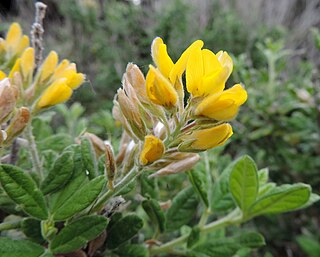
Chives, scientific name Allium schoenoprasum, is a species of flowering plant in the family Amaryllidaceae that produces edible leaves and flowers. Their close relatives include the common onions, garlic, shallot, leek, scallion, and Chinese onion.

Royal Botanic Gardens, Kew is a non-departmental public body in the United Kingdom sponsored by the Department for Environment, Food and Rural Affairs. An internationally important botanical research and education institution, it employs 1,100 staff. Its board of trustees is chaired by Dame Amelia Fawcett.

Cytisus is a genus of flowering plants in the family Fabaceae, native to open sites in Europe, western Asia and North Africa. It belongs to the subfamily Faboideae, and is one of several genera in the tribe Genisteae which are commonly called brooms. They are shrubs producing masses of brightly coloured, pea-like flowers, often highly fragrant. Members of the segregate genera Calicotome, Chamaecytisus, and Lembotropis are sometimes included in Cytisus.

Joseph Marie Henry Alfred Perrier de la Bâthie was a French botanist who specialized in the plants of Madagascar.

Myrica is a genus of about 35–50 species of small trees and shrubs in the family Myricaceae, order Fagales. The genus has a wide distribution, including Africa, Asia, Europe, North America and South America, and missing only from Australia. Some botanists split the genus into two genera on the basis of the catkin and fruit structure, restricting Myrica to a few species, and treating the others in Morella.

Tigridia, is a genus of bulbous or cormous flowering plants belonging to the family Iridaceae. With common names including peacock flowers, tiger-flowers or shell flowers, they have large showy flowers; and one species, Tigridia pavonia, is often cultivated for this. The approximately 60 species in this family grow in the Americas, from Mexico down to Chile.

Micromeria is a genus of flowering plants in the mint family, Lamiaceae, widespread across Europe, Asia, Africa, and North America, with a center of diversity in the Mediterranean region and the Canary Islands. It is sometimes placed within the genus Satureja. The name is derived from the Greek words μῑκρος (mīkros), meaning "small," and μερίς (meris), meaning "portion," referring to the leaves and flowers. Common names include savory and whitweed.
Myrica rivas-martinezii is a species of plant in the Myricaceae family. It is endemic to three of the Canary Islands (Spain). It is threatened by habitat loss and fewer than 100 plants are known.

Quercus martinezii is a species of oak found in southwestern and central Mexico. It has been found in Nayarit, Jalisco, Michoacán, Guerrero, and Oaxaca states. It is placed in Quercus section Quercus.

I. M. Johnston, was a United States botanist. He studied at Pomona College in Claremont, California and at Harvard University. His plant collections are housed in the Rancho Santa Ana Botanic Garden, in Claremont, and also in the Gray Herbarium of Harvard University.

Lapiedra is a genus of Western Mediterranean plants in the Amaryllis family. It now contains only one known species, Lapiedra martinezii, native to Spain and Morocco.

Sairocarpus is a genus of the family Plantaginaceae, and is one of a group of plants commonly known as 'snapdragons'. It has ten accepted species and is being considered to include many species formerly considered as New World species of Antirrhinum.

Catoferia is a small genus of plants in the family Lamiaceae composed of only four different species. First described in full by George Bentham in 1876, said species are native to southern Mexico, Central America, Colombia and Peru. Amongst all four species, only Catoferia chiapensis are known to grow across a wide area, their growth recorded in southern Mexico, Guatemala, Peru and Belize. Growth of the other three variants is believed to be limited to Southern Mexico. The beginning of the genus Catoferia is thought trace back to the Cretaceous era, making it around 55 to 65 million years old.

Rivasgodaya is a monotypic genus of flowering plants belonging to the legume family, Fabaceae. It just contains one species, Rivasgodaya nervosa.
Plants of the World Online (POWO) is an online database published by the Royal Botanic Gardens, Kew. It was launched in March 2017 with the ultimate aim being "to enable users to access information on all the world's known seed-bearing plants by 2020". The initial focus was on tropical African Floras, particularly Flora Zambesiaca, Flora of West Tropical Africa and Flora of Tropical East Africa.

World Flora Online is an Internet-based compendium of the world's plant species.
Petrocoptis is a genus of flowering plants belonging to the family Caryophyllaceae.

Zephyranthes martinezii, is a species of flowering plant in the rain lily genus Zephyranthes, family Amaryllidaceae, native to northern Argentina. As its synonym Habranthus martinezii it has gained the Royal Horticultural Society's Award of Garden Merit.
Stenocereus martinezii is a species of flowering plant in the family Cactaceae, native to Sinaloa in Mexico. A candelabriform cactus typically 5 to 7 m tall, it is easy to propagate from cuttings, so local people use it to build live fences.
Catoferia martinezii is a species of flowering plant in the family Lamiaceae. It is native to Mexico, Guerrero.














